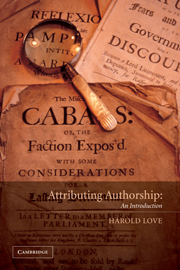Book contents
- Frontmatter
- Contents
- Acknowledgements
- List of abbreviations
- Introduction
- 1 Individuality and sameness
- 2 Historical survey
- 3 Defining authorship
- 4 External evidence
- 5 Internal evidence
- 6 Stylistic evidence
- 7 Gender and authorship
- 8 Craft and science
- 9 Bibliographical evidence
- 10 Forgery and attribution
- 11 Shakespeare and Co.
- 12 Arguing attribution
- Notes
- Select bibliography
- Index
12 - Arguing attribution
Published online by Cambridge University Press: 22 September 2009
- Frontmatter
- Contents
- Acknowledgements
- List of abbreviations
- Introduction
- 1 Individuality and sameness
- 2 Historical survey
- 3 Defining authorship
- 4 External evidence
- 5 Internal evidence
- 6 Stylistic evidence
- 7 Gender and authorship
- 8 Craft and science
- 9 Bibliographical evidence
- 10 Forgery and attribution
- 11 Shakespeare and Co.
- 12 Arguing attribution
- Notes
- Select bibliography
- Index
Summary
In the previous chapters we have looked at various aspects of the present and past practice of attribution studies. In the course of this exploration a number of general questions were raised about the nature of the attributionist project and the modes of argument employed in it. The time has now come to draw this scattered material together.
CRITERIA OF PROOF
The criteria for the acceptance of an attribution as proven have traditionally been based on legal models for the evaluation of evidence. The law (especially criminal law) is charged with making decisions about matters of fact and motive concerning events which were rarely the object of careful scrutiny at the time: so is attributional scholarship. The law, at least in countries with a common law tradition, is based on both adversarial and deliberative modes of argument, the first instanced in the plea of the barrister or attorney and the second in the summing up of the judge. Most scholarly books and articles can be classified under one or the other category. Both institutions have to assess the credibility of testimony and have developed elaborate protocols for doing this. Certain basic standards of proof are common to both. In criminal law, guilt has to be proved beyond reasonable doubt; in civil cases the balance of probability determines the findings.
- Type
- Chapter
- Information
- Attributing AuthorshipAn Introduction, pp. 209 - 227Publisher: Cambridge University PressPrint publication year: 2002

